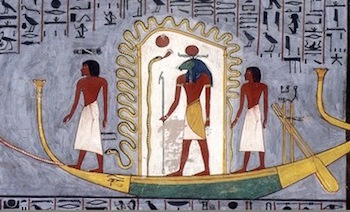Sia (or Saa) was the divine personification of perception, in particular, the accurate perception which is necessary in order to understand the truth. Sia was closely associated with Hu (the personification of an utterance which is backed up by truth and authority) and the two often appear together in underworld texts. Sia would seem to have been the more prominent of the two, perhaps because perceiving the truth was seen as a necessary precursor to speaking with authority.
According to one myth from the Heliopolitan Ennead cosmology, both Sia and Hu came into being from the drops of blood spilled from the cut phallus of the god Atum. This has been seen by some as a reference to circumcision. In the Memphite cosmology, Sia and Hu represented the creative power of Ptah. Sia was the mind or heart of Ptah, while Hu was his tongue. They are also linked to Thoth, in his role as the god of knowledge and Heka, the God of Magic.
Although neither Sia nor Hu were worshipped as independent deities, they are frequently referred to in texts concerning Egyptian religion and philosophy.
The Pyramid Texts describe Sia as “he who is in charge of wisdom”, and confirm that he carries the sacred scroll of Ra. They also confirm Hu as the personification of divine authority.

In the Book of Gates, Sia and Hu are the constant companions of Ra as he travels through the underworld. The Coffin Texts confirm Sia as the narrator and witness of mythic events. They give Sia a central role in the important ritual of the Opening of the Mouth. There are also examples where spell 325, which generally refers to Heka (magic), instead refers to Hu. Texts at Dendera suggest that images were produced in accordance with rules set down by Sia and the images themselves are referred to as the “Words of Sia”, which would seem to almost combine the two concepts.
The treatment of Sia and Hu in hieroglyphs is also worth considering. While the term “Sia” always means perception or intelligence in ancient Egyptian, there is an interesting dual meaning for the term “Hu”. It can refer to the spoken word (or an utterance with authority) but can also refer to food.
There is an obvious connection between words which leave the mouth, and food which is placed in the mouth, but the connection seems to go deeper than that. After all, the Offering Formula specifically describes a “voice offering” reinforcing the connection between the spoken word and the magical creation of sustenance.
Bibliography
- Watterson, Barbara (1996) Gods of Ancient Egypt
- Wilkinson, Richard H. (2003) The Complete Gods and Goddesses of Ancient Egypt
Copyright J Hill 2018